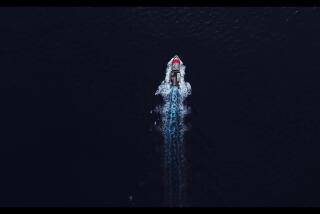Deputies of the Deep
- Share via
Mark Ballin knows the locked-closet emotional grip of plunging underwater into zero visibility, peering through his goggles into the ocean’s murky blackness, feeling himself knock time and again against elusive things.
Sunken ships? Sea creatures? Dead bodies?
“It’s like being blind down there,” he says. “It’s claustrophobic, like being in some tiny closet with the lights out, feeling your way by Braille.”
Ballin, a 28-year-old L.A. native, is an underwater cop, the submerged counterpart to the better-known “Baywatch” patrol. He’s a member of the Los Angeles County Sheriff’s Department’s elite underwater dive teams, this one based in Marina del Rey.
In his line of work, if something down there feels like a dead body, it usually is.
In all kinds of weather, 24 hours a day, Ballin and his 15 diving colleagues are called out to rescue everything from submerged boaters and missing scuba divers to ships on fire and wayward aircraft that have crashed into the sea.
Based in the world’s largest man-made marina and located near one of its busiest coastal airports, the divers spread their human dragnet in depths of 100 feet or more to retrieve wreckage and bodies, both dead and alive.
Like their colleagues on land, these officers have learned some gritty lessons.
They know bodies seldom drop straight down but will drift with the current. And that a filmy sheen over the eyes of a corpse means the person probably died on land.
They know how to preserve weapons pulled from the deep--that the serial number of a retrieved handgun will disappear due to oxidation of the salty water.
And they know the sea’s sandy bottom will become stirred with silt at the slightest movement underwater, forcing them to practice stealth.
The divers do their underwater work for more than just money. For many, it’s a chance to live out boyhood dreams to not only be near the water, but be deep down in it.
“I love coming to work and getting right into the water,” said Deputy John Rochford, a 16-year veteran of the dive team. “I grew up right here in West Los Angeles and as a Boy Scout I saw what the Coast Guard did and was fascinated.
“When I got older, I spent a few years in the Coast Guard. When I got out, I was lucky enough to land this job.”
Last month, the marina team made 50 dives over several days searching for a veteran U.S. Secret Service supervisor who drowned near Long Beach after he and a fellow agent were thrown out of their motorboat during a nighttime pleasure trip near the Queen Mary.
As the warmer weather approaches, the crew knows that rescue season is near.
On Wednesday, a handful of divers prepared for the busy months ahead by taking part in a timed underwater drill, hauling up weighted dummies from a submerged van.
In an era of fiscal austerity, the divers--most of them former lifeguards, swimmers and water jocks--have banded together to pay for their own expensive rescue equipment.
Through a payroll deduction plan and donations by local businesses, they have spent tens of thousands of dollars to purchase pricey sonar equipment, special nitrogen-rich dive tanks and underwater communications gear they believe they need to do their job right.
“Basically, what the department furnishes us with is the wetsuit,” said Sgt. Jack Mayer, the dive team supervisor.
The tight-knit group, whose members often pleasure dive together on weekends, are encouraged to make suggestions to supervisors about new state-of-the-art equipment, according to Mayer. For example, the divers began using special nitrogen-rich tanks to help them stay underwater longer after one member read about them in a diver’s magazine.
They have bought special underwater cameras, video equipment and a communications system that allows divers to communicate with supervisors onshore during rescue missions where seconds are critical.
Last year, the new equipment helped the divers save time in recovering four bodies from a small plane that crashed several miles offshore while approaching Los Angeles International Airport.
Along with rescues, the divers assist in retrieving criminal evidence. Last summer, they scoured the floor of the marina for evidence in a murder case involving a 28-year-old Mar Vista woman whose body had been found underwater lashed to an outboard motor.
They have rescued people trying to commit suicide, drunken boaters who have fallen overboard and luckless motorists whose vehicles slipped underwater as they put their boats into the water.
The marina team, the biggest of four run by the Sheriff’s Department, covers the busiest area: the Santa Monica coastline and Marina del Rey, patrolling in a 29-foot rescue boat equipped with night-sight radar.
On Wednesday, the crew watched as the orange van listed and sank beneath the surface like some mini-Titanic taking its historic plunge.
*
Within minutes, stocky Mark Ballin stood on a nearby dock, an oxygen tank strapped over his street clothes, ready to simulate a rescue dive to retrieve two submerged motorists.
One by one, six divers in all slipped 15 feet to the marina floor, feeling their way in the blackness, pulling two dummies and several other items from the van. If they missed something, they were sent back to get it.
The work is often dangerous. The water sometimes is so dirty they must shower afterward with antibacterial soap. Making a living in the water compensates for much of that. So does the lure of that new equipment they’re lusting after--like hand-held sonar and robotic cameras for deep-sea rescues.
“On this team, there’s no rank, just a great equilibrium,” says Mayer, 52, a former Army Special Forces member. “Only thing is, I get stuck with all the paperwork.”
Times staff writer Duke Helfand contributed to this story.
More to Read
Sign up for Essential California
The most important California stories and recommendations in your inbox every morning.
You may occasionally receive promotional content from the Los Angeles Times.













